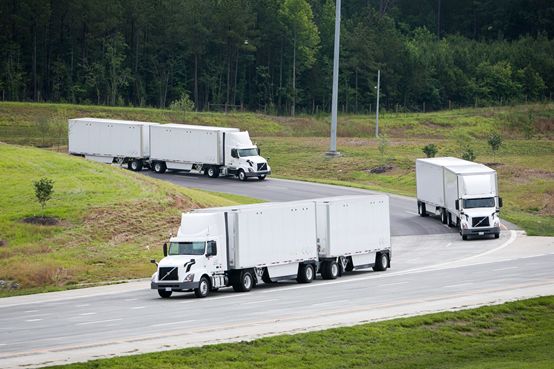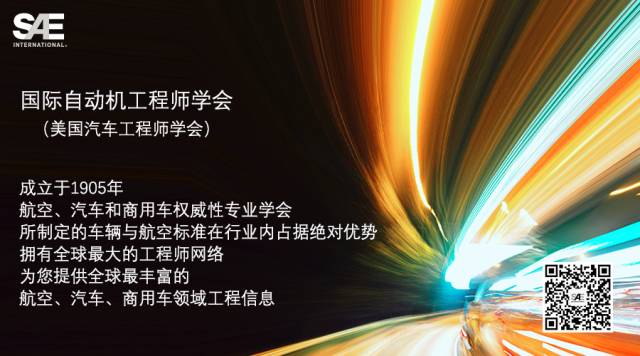 各种ZF传感器所获取的数据能够服务于车辆的传动系统与制动系统,从而提高车辆的安全性。(图片来源:ZF公司)
各种ZF传感器所获取的数据能够服务于车辆的传动系统与制动系统,从而提高车辆的安全性。(图片来源:ZF公司) 编队行驶可以带来很多好处,但是V2V认证的规则仍然不明朗。
编队行驶可以带来很多好处,但是V2V认证的规则仍然不明朗。
今天,无论是卡车运营商还是商用车供应商,都在努力提升车辆的安全性,他们一方面正在推动高级驾驶辅助系统(ADAS)的标准化,另一方面则在探索车对车(V2V)通信技术的应用潜能。尽管V2V通信拥有众多好处,但该技术能否普及开来依然是个未知数。
全球规模最大的几家汽车管理公司的高管是汽车安全的积极倡导者。比如在近期由沃尔沃(Volvo)卡车与联邦快递(FedEx)共同举行的V2V技术演示会上,FedEx 的CEO John Smith就反复强调要提升车辆安全性。而他的同事则具体阐述了公司将为车队全面安装安全系统的计划。
联邦快递通信主管MicheleEhrhart女士表示:“在今年年底,我们将为公司的所有车辆配上碰撞缓解、侧翻稳定性控制以及车道偏离预警功能。并且,除了最陈旧的车辆外,我们其余的所有车辆都安装了自适应巡航控制系统(ACC)系统。”
卡车制造商们也进而纷纷表示,买家们都愿意为安装汽车安全系统而支付更多的费用。人身安全是无价的,而保护车辆和货物的经济回报是可以估量的。
戴姆勒(Daimler)卡车部门北美福莱纳卡车(Freightliner Trucks)分部战略总经理 Kary Schaefer 表示:“由于安全系统能够减少交通事故,并提高车辆的运行时间,因此车辆安全性的提升能够大幅提高车辆驾驶过程中的经济性。需要指出的是,主动安全系统与车辆推进系统及网联系统,并称为汽车行业的三大投资领域。”
在卡车供应商与运营商的共同努力下,ADAS系统的配置率有所上升。除此之外,研究者们也开始探究起V2V通信技术的潜在优势。汽车行业目前采用的V2V通信技术大多基于标准版5.9 GHz频段专用短程通信技术(DSRC),用于车辆与车辆以及车辆与路边信号装置的“交流”。值得一提的是,越来越多的公司开始测试V2V通信技术应用于车辆编队行驶的好处。由于编队中的车辆能够互相告知制动时间,因此行车安全性得到了极大提升。此外,V2V技术的应用还能够缩短车距,帮助整个车队节约10%的油耗。
ZF公司ADAS系统、车辆自动化与商用车技术研发部门主管Dan Williams 先生表示:“V2V通信技术将被首次应用于车辆编队。而车辆与基础设施通信(V2I)技术的应用,能够帮助车辆在有限的区域环境里互相传递较为有价值、且获取成本不高的信息。”
V2V技术的应用可以有效缩短安全车距,并确保整个卡车编队做到同时减速。此外,沃尔沃还将V2V通信与自适应巡航控制(ACC)系统相结合,提供了更高的冗余,以确保当编队头车放缓速度时,其它车辆也相应立刻放缓速度。
Volvo卡车北美分部产品规划副总裁KeithBrandis先生表示:“我们在标准ACC系统的基础上加上了V2V通信技术。这样,当卡车编队头车减速行驶或刹车时,后续车辆就能够利用协作式ACC系统的DSRC技术获取头车的行驶信息。”
虽然研究人员预测V2V通信技术能够为车队运营商带来巨额利润,但该技术的应用前景却受到了质疑。具体而言,如果采用编队控制系统对车队进行控制,那么即使较小规模的车队也能够获取一定的运营利润;如果车队规模较大,就能获得更大的利润。但在车队规模较小的情况下,额外支付费用再添置车辆网联技术就显得没有必要。
Williams先生表示:“在这样一个混合环境中,采用V2V通信技术有时候能够帮助我们获取到有用信息,有时候却不能。如果获取的信息不可靠,那么司机在做出安全决策时也就不会参考这一信息了。”
如今,美国国家公路交通安全管理局(NHTSA)迟迟没有推出有关强制新车安装V2V通信设备的规定,这进一步引发了人们的猜测。而蜂窝通信技术的提倡者们则进一步进行宣传,称5G通信技术能够提供足够的带宽,给汽车行业带来很多好处。
以蜂窝通信技术为基础的V2V技术简称为C-V2V技术。由于采用了未来几年内有望普及的蜂窝调制解调器,该技术可以省下原先的DSRC链接技术的成本,因此已经引起了一些汽车制造商们的兴趣。由于汽车或卡车的C-V2V技术配置率均较低,因此一些汽车公司开始考虑出售5.9-GHz频段DSRC技术,不过这一想法遭到了大多数DSRC技术支持者的反对。
Brandis先生表示:“我们正在与美国联邦通信委员会(FCC)合作共同保护我们的无线频段。如果我们获得的带宽变窄,那么我们发出的数据量也会有所减少。由于汽车在未来发送的数据量将会越来越多,因此这一问题事关汽车未来发展。”
如果将来通信基础设施能够做到处理大量的数据,那么我们距离实现所有车辆的自动化也就不远了。具体来说,无人驾驶汽车在接收到与路况及天气状况相关的数据后,能够有效提升行驶安全。车与车之间能共享路边行人的信息,以及实时交通流量信息。V2V通信技术所获取的数据,通常比车载传感器所获取的数据涉及面更广。因此,随着自动驾驶卡车的不断普及,提高环境数据的数量与置信度变得至关重要。
Williams继续解释说:“传感范围的大幅提升有助于车辆更好地发现周围的交通安全隐患,使横向与纵向的控制更好地结合起来。而这些自动驾驶功能的实现,将提升商用车的安全性与效率,并进而提升汽车的自动化程度。第一批自动驾驶车辆将用于导航难度相对较低的任务中,如在偏远地区的公路上将矿物从矿井运输至火车站,或在特定高速公路上保持同车道行驶。”
Truck owners and commercial-vehicle suppliers are ramping up their safety efforts, making more advanced driver-assistance systems (ADAS) standard while looking at the potential benefits of vehicle-to-vehicle (V2V) communications. Though V2V can bring many benefits, widespread usage remains shrouded with questions.
Support for improved safety comes from some of the top executives of the largest vehicle fleets. FedEx CEO John Smith repeatedly commented on the need for improved safety during a recent Volvo Trucks-FedEx V2V demonstration. Associates detailed the push to fully equip the FedEx fleet with safety systems.
“By the end of the year, we will have collision mitigation, rollover stability control and lane-departure warnings on all our vehicles,” said FedEx communications director Michele Ehrhart. “We already have adaptive cruise control on all but the oldest vehicles.”
Truck makers are moving in lockstep, noting that it’s easy for buyers to justify the cost of safety systems. Safeguarding human lives is priceless, but protecting vehicles and cargo has a definable financial payback.
“There’s a very strong business case for improving safety,” said Kary Schaefer, general manager of strategy for Daimler Trucks North America’s Freightliner Trucks. “Every accident that safety systems prevent provides more uptime for the fleet. Active safety is one of three major areas of investment for the industry, along with propulsion and connectivity.”
As suppliers and owners move to equip more vehicles with ADAS, researchers are also exploring the potential benefits of V2V. The industry has standardized 5.9 GHz dedicated short-range communications (DSRC) to let vehicles talk to each other and communicate with roadside beacons. Many companies are testing V2V’s benefits for platooned convoys. When vehicles can tell each other when they’re braking, safety can be improved. Tightening distances between trucks can bring fuel savings up to 10%.
“The first use of V2V communication will be platooning,” said Dan Williams, director of ADAS and autonomy, commercial vehicle technologies, at ZF. “Vehicle-to-infrastructure communication could allow more cost-effective information in a restricted area environment.”
Safely shortening following distances means ensuring that trucks slow down synchronously. Volvo provides redundancy by closely linking adaptive cruise control (ACC) with V2V communications. That helps ensure that all vehicles immediately react when the lead vehicle slows.
“We’re using our standard ACC and adding a layer on top, using V2V,” said Keith Brandis, vice president for product planning at Volvo Trucks North America. “Cooperative ACC uses DSRC to let trailing vehicles know immediately when the lead truck is slowing or braking.”
Researchers feel V2V brings major financial benefits, but its usage remains in question. Platooning brings benefits even if the operating fleets are small. Greater benefits occur when more trucks can communicate, bringing broader safety improvements. It can be difficult to justify connectivity costs when only a few vehicles can talk to each other.
“In a mixed environment where sometimes this information might be available, sometimes not, it can become a source of potentially useful information, but if it is unreliable you may not want to base safety decisions on this data source,” Williams said.
The National Traffic Highway Safety Administration's (NHTSA) tardiness in mandating a rollout date has created questions around adoption. Cellular promoters say that 5G connections provide enough bandwidth to provide many of the benefits.
Called C-V2V, it is gaining some interest from automakers who feel they can eliminate the cost of a DSRC link by using cellular modems that are likely to be on most cars in a few years. Given the lack of usage in cars and trucks, some groups have discussed selling some of the 5.9-GHz DSRC spectrum. That’s not palatable for most DSRC proponents.
“We’re working with the FCC to protect our wireless spectrum,” Brandis said. “If we get narrower bandwidth, it will restrict the amount of data we can send. That’s important for the future, when even more data will be sent.”
Having a communications infrastructure capable of handling lots of data is viewed as an important element in the drive to automate all driving. Data on road and weather conditions can help autonomous vehicles navigate safely. Vehicles could also share information about pedestrians near roadways, as well as providing real-time traffic info. V2V input is often viewed as sensor information that extends farther than on-board sensors. Increasing the volume and confidence levels of environmental data will be important as autonomous trucks move from limited applications to mainstream driving.
“Further out, we will use more sensing to identify safety issues all around the vehicle, and combine longitudinal and lateral control,” Williams said. “These associated functions will help to improve safety and efficiency of commercial vehicles, and lead to increasing levels of automation. The first automated vehicles will appear in duty cycles that are relatively easy to navigate, such as hauling from a mine pit to a railhead on a remote road, or maintaining a lane on a limited access highway.”
Author: Terry Costlow
Source: SAE Truck & Off-highway Engineering Magazine
等级
打分
- 2分
- 4分
- 6分
- 8分
- 10分
平均分
